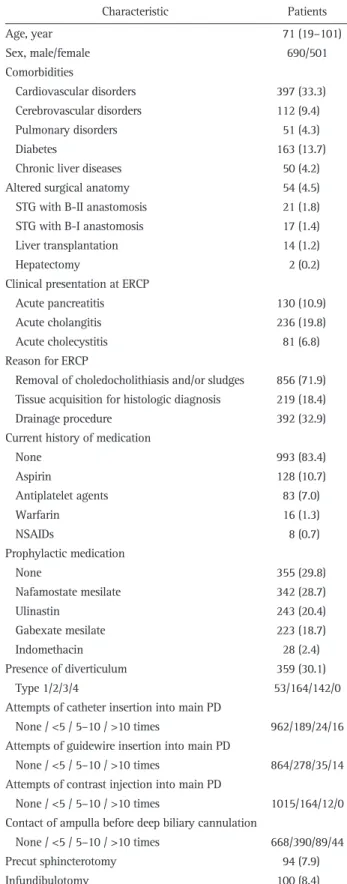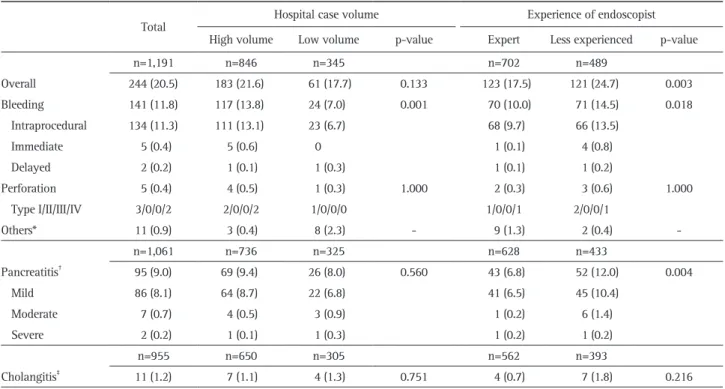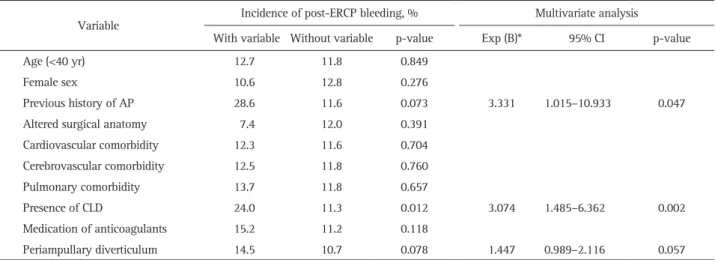Background/Aims: Few studies have addressed the rela- tionship between the occurrence of adverse events (AEs) in endoscopic retrograde cholangiopancreatography (ERCP) and hospital case volume or endoscopist’s experience with inconsistent results. The aim of our study was to investigate the impact of hospital case volume and endoscopist’s expe- rience on the AEs associated with ERCP and to analyze pa- tient- and procedure-related risk factors for post-ERCP AEs.
Methods: From January 2015 to December 2015, we pro- spectively enrolled patients with naïve papilla who underwent ERCP at six centers. Patient- and procedure-related variables were recorded on data collection sheets at the time of and after ERCP. Results: A total of 1,191 patients (median age, 71 years) were consecutively enrolled. The overall success rate of biliary cannulation was 96.6%. Overall, 244 patients (20.5%) experienced post-ERCP AEs, including pancreatitis (9.0%), bleeding (11.8%), perforation (0.4%), cholangitis (1.2%), and others (0.9%). While post-ERCP pancreatitis (PEP) was more common when the procedure was performed by less experienced endoscopists, bleeding was more common in high-volume centers and by less experienced endosco- pists. Multivariate analysis showed that a less experience in ERCP was significantly associated with PEP (odds ratio [OR], 1.630; 95% confidence interval [CI], 1.050 to 2.531;
p=0.030) and post-ERCP bleeding (OR, 1.439; 95% CI, 1.003 to 2.062; p=0.048). Conclusions: Our study demonstrated that overall AEs following ERCP were associated with the experience of the endoscopist. To minimize post-ERCP AEs, rigorous training with a sufficient case volume is required, and treatment strategies should be modified according to the
endoscopist’s expertise. (Gut Liver 2020;14:257-264) Key Words: Cholangiopancreatography, endoscopic retro- grade; Adverse events; Hospital volume; Endoscopic experi- ence
INTRODUCTION
Since the introduction of endoscopic sphincterotomy in 1974,
1,2endoscopic retrograde cholangiopancreatography (ERCP) has evolved from a diagnostic to a therapeutic procedure for the management of various pancreatobiliary disorders.
3How- ever, ERCP is a relatively invasive procedure associated with potential adverse events (AEs) that range from trivial incidents to major life-threatening crises requiring additional hospital stays or interventional procedures. The major AEs after ERCP are well recognized and the reported incidence varies widely across different studies ranging for 5% to 10% in pancreatitis, 1% to 4% in hemorrhage, 1% to 5% in cholangitis, and 1% to 2% in perforation. The magnitude and independence of the as- sociated risk factors varies widely and are uncertain, but the procedure-related mortality was about 1%.
4-6Although ERCP procedures are becoming increasingly safer owing to techni- cal advancements and the growing experience of endoscopists, ERCP-related AEs cannot be completely avoided. There may be an association between ERCP case volume and endoscopist’s expertise with outcomes and post-ERCP AEs. Several previous univariate and multivariate analyses including large series of patients have identified either patient- or procedure-related risk factors for ERCP-related AEs.
7-12However, controversy remains
This is an Open Access article distributed under the terms of the Creative Commons Attribution Non-Commercial License (http://creativecommons.org/licenses/by-nc/4.0) which permits unrestricted non-commercial use, distribution, and reproduction in any medium, provided the original work is properly cited.
Impact of Hospital Volume and the Experience of Endoscopist on Adverse Events Related to Endoscopic Retrograde Cholangiopancreatography:
A Prospective Observational Study
Hyun Jik Lee
1, Chang Min Cho
2,3, Jun Heo
3, Min Kyu Jung
3, Tae Nyeun Kim
4, Kook Hyun Kim
4, Hyunsoo Kim
5, Kwang Bum Cho
1, Ho Gak Kim
6, Jimin Han
6, Dong Wook Lee
6, and Yoon Suk Lee
71


